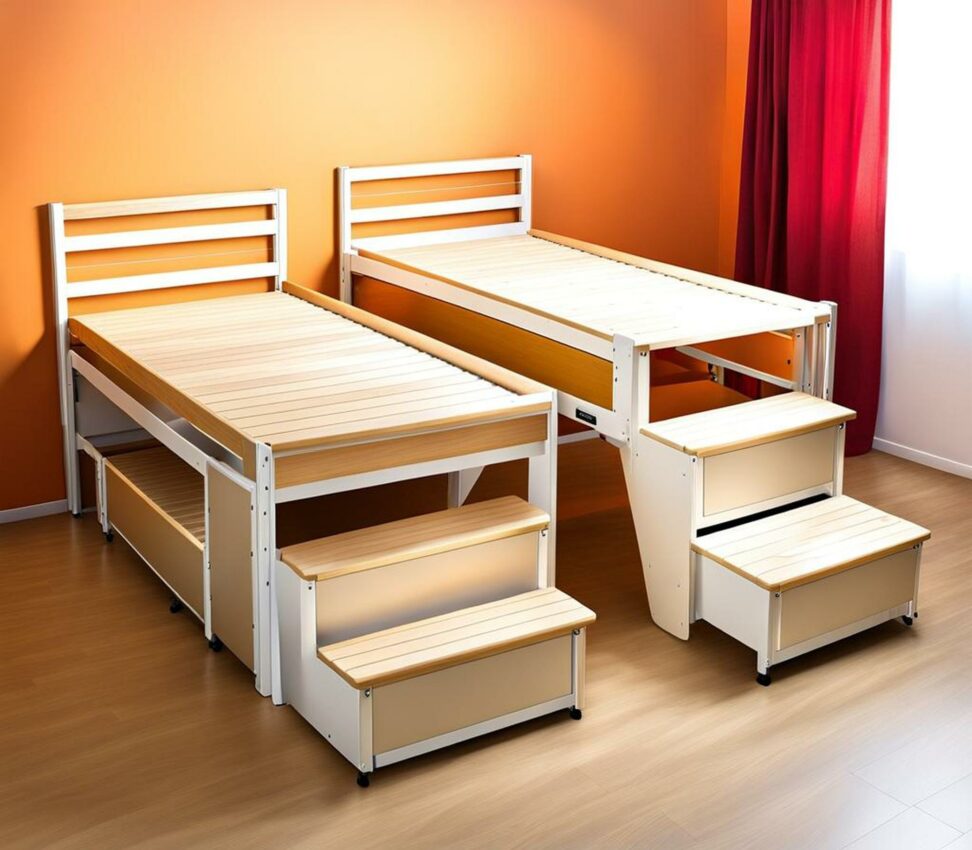Make High Beds Safely Accessible for Seniors with Bed Steps
Getting in and out of high beds can be challenging and dangerous for many elderly individuals. High mattresses and bed frames can make it difficult and risky for seniors, especially those with mobility issues, to climb in and out of bed. This often leads to falls and injuries, impacting their health, independence, and dignity.
Bed steps provide a simple yet effective solution to make high beds more easily accessible for the elderly. These compact steps act as an intermediate platform between the floor and the bed, allowing seniors to safely ascend and descend with ease. With key features like adjustable heights, handrails, and non-slip surfaces, bed steps can greatly improve safety and accessibility for the elderly in tall beds.
Challenges of High Beds for the Elderly
Climbing in and out of high mattresses on a daily basis poses various difficulties for many seniors:

- Difficulty hoisting themselves onto tall beds, especially for those with joint pain or limited mobility
- Risk of falling and injuries like hip fractures while getting in or out of bed
- Loss of independence having to rely on others like caregivers for help accessing their bed
These challenges put elderly individuals at risk of losing autonomy and dignity. Falls are a leading cause of hospitalization and disability for seniors. A study showed that over 95% of hip fractures in the elderly are caused by falling. This makes accessibility a major concern for high beds.
How Bed Steps Help Seniors with High Beds
Bed steps address the accessibility issues of high beds in various ways:
- Provide an intermediate platform - The steps act as "stairs" between the floor and bed for easy access.
- Stable handrails give support - Handrails on one or both sides provide stability.
- Adjustable height - Steps can be adjusted to fit the bed height.
- Non-slip surfaces prevent falls - Textured surfaces prevent slips and falls.
These features allow seniors to safely get on the elevated bed surface at their own pace. The handrails provide stability for balance and grip support while getting up and down the bed steps. Adjustable heights also mean the steps can be customized to fit beds of different heights.
Key Features to Look for in Bed Steps
When choosing bed steps for the elderly, look for models with these key features:
| Adjustable height range | To accommodate different bed heights from 6 to 18 inches |
| Weight capacity over 300 lbs | For safety of heavier individuals |
| Handrails on one or both sides | For stability support while climbing |
| Non-slip, textured standing surfaces | To prevent slips and falls |
| Compact, foldable design | For easy storage and portability |
| Motion sensor night lights | For visibility and preventing falls at night |
Types of Bed Steps for Seniors
There are various types of bed steps designed to suit different needs:
Standard Bed Steps
Standard bed steps come in single or double step options with:
- Fixed or adjustable heights suitable for most stationary beds
- Non-slip standing surfaces and handrails for stability
- Durable steel or aluminum construction
These are the most commonly used bed steps as they suit most beds and bedrooms.
Foldable Bed Steps
Foldable bed steps feature:
- Hinged joints allowing the step(s) to fold for storage and transport
- Ideal for traveling and using in tight spaces like RVs or guest rooms
- Raised edges prevent slippage when folded
The foldable design maximizes portability making them great for seniors who travel frequently or with limited space.
Bed Step Stools
Bed step stools offer a basic single-step option with:
- Compact, lightweight and affordable design
- Provide just enough lift for basic accessibility
- Great for occasional use or when budget is a factor
These single-step stools give a basic accessibility boost without complex features.
Bed Step Ladders
Bed step ladders come with:
- Multiple steps for very tall beds over 18 inches high
- Handrails on both sides for enhanced stability
- Often have wider/deeper steps
The multi-step design provides help getting on really high surfaces. But they tend to take up more space.
Choosing the Right Bed Step Size
Choosing the right bed step size involves:
- Measuring bed height from floor to top of mattress
- Considering the size of bed frame for positioning
- Selecting regular, mini, or XL step size accordingly
It's important to measure correctly and factor the bed dimensions to get a properly fitting bed step solution.
Safety Tips for Using Bed Steps
To safely use bed steps:
- Position bed steps securely against a wall for added stability
- Have grab bars installed near the bed for support
- Check weight capacity before use
- Supervise initial uses until confident
Bed steps greatly improve accessibility but some precautions are vital, especially for elderly individuals still getting used to the steps.
Maintaining Bed Steps
Simple maintenance tips include:
- Clean surface dirt regularly with a damp cloth
- Check for damage and tighten any loose bolts
- Follow specific care instructions from manufacturer
With periodic cleaning, safety checks, and preventative maintenance, bed steps will serve seniors reliably for a long time.
Bed steps provide seniors a simple solution to safely access high beds and maintain independence at home. Key features like adjustable height, handrails, non-slip surfaces, and compact designs maximize accessibility, safety and ease of use. Considering factors like bed height, existing mobility issues, and usage needs helps choose the right bed step option. With proper selection, use and care, bed steps eliminate the difficulties of high beds and greatly improve quality of life for the elderly.